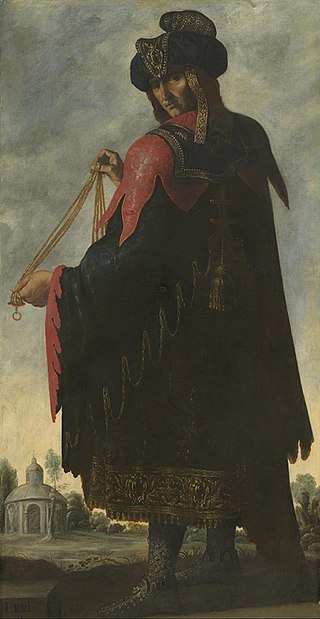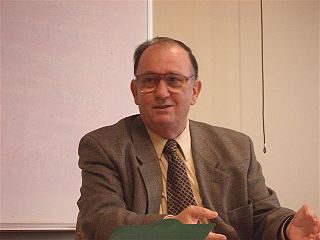In the Book of Exodus, Amram is the husband of Jochebed and father of Aaron, Moses and Miriam.
The Essenes were a mystic Jewish sect during the Second Temple period that flourished from the 2nd century BCE to the 1st century CE.

The Dead Sea Scrolls, also called the Qumran Caves Scrolls, are a set of ancient Jewish manuscripts from the Second Temple period. They were discovered over a period of 10 years, between 1946 and 1956, at the Qumran Caves near Ein Feshkha in the West Bank, on the northern shore of the Dead Sea. Dating from the 3rd century BCE to the 1st century CE, the Dead Sea Scrolls include the oldest surviving manuscripts of entire books later included in the biblical canons, along with extra-biblical and deuterocanonical manuscripts from late Second Temple Judaism. At the same time, they cast new light on the emergence of Christianity and of Rabbinic Judaism. Almost all of the 15,000 scrolls and scroll fragments are held in the Shrine of the Book at the Israel Museum, located in the city of Jerusalem. The Israeli government's custody of the Dead Sea Scrolls is disputed by Jordan and the Palestinian Authority on territorial, legal, and humanitarian grounds—they were mostly discovered following the Jordanian annexation of the West Bank and were acquired by Israel after Jordan lost the 1967 Arab–Israeli War—whilst Israel's claims are primarily based on historical and religious grounds, given their significance in Jewish history and in the heritage of Judaism.

Levi was, according to the Book of Genesis, the third of the six sons of Jacob and Leah, and the founder of the Israelite Tribe of Levi and the great-grandfather of Aaron, Moses and Miriam. Certain religious and political functions were reserved for the Levites.

Belial is a term occurring in the Hebrew Bible/Old Testament which later became personified as the devil in Christian texts of the New Testament. Alternate spellings include Baalial, Balial, Belhor, Beliall, Beliar, Berial, Bylyl and Beliya'al. In the Secret Book of John, an early Gnostic text, the ruler of the underworld is referred to as Belias.

According to the Bible, Jochebed was a daughter of Levi and mother of Miriam, Aaron and Moses. She was the wife of Amram, as well as his aunt. No details are given concerning her life. According to Jewish legend, she is buried in the Tomb of the Matriarchs, in Tiberias. In the New Testament, she is praised for her faith in God.

The Book of Enoch is an ancient Hebrew apocalyptic religious text, ascribed by tradition to the patriarch Enoch who was the father of Methuselah and the great-grandfather of Noah. The Book of Enoch contains unique material on the origins of demons and Nephilim, why some angels fell from heaven, an explanation of why the Genesis flood was morally necessary, and a prophetic exposition of the thousand-year reign of the Messiah. Three books are traditionally attributed to Enoch, including the distinct works 2 Enoch and 3 Enoch.

Pesher, from the Hebrew root meaning "interpretation," is a group of interpretive commentaries on scripture. The pesharim commentaries became known from the discovery of the Dead Sea Scrolls. The pesharim give a theory of scriptural interpretation of a number of biblical texts from the Hebrew Bible, such as Habakkuk and Psalms.

According to the Torah, Kehath or Kohath was the second of the sons of Levi and the patriarchal founder of the Kehathites, one of the four main divisions of the Levites in biblical times. In some apocryphal texts, such as the Testament of Levi and the Book of Jubilees, Levi's wife, Kehath's mother, is Milkah, a daughter of Aram.

The War of the Sons of Light Against the Sons of Darkness, also known as War Rule, Rule of War and the War Scroll, is a manual for military organization and strategy that was discovered among the Dead Sea Scrolls. The manuscript was among the scrolls found in Qumran Cave 1, acquired by the Hebrew University of Jerusalem and first published posthumously by Eleazar Sukenik in 1955. The document is made up of various scrolls and fragments including 1QM, and 4Q491–497. It is possible that The War of the Messiah is the conclusion to this document. The 4Q491–497 fragments were published by Maurice Baillet in Discoveries in the Judaean Desert, volume 7 and comprise a shorter recension of the War Scroll.
The Community Rule, which is designated 1QS and was previously referred to as the Manual of Discipline, is one of the first scrolls to be discovered near khirbet Qumran, the scrolls found in the eleven caves between 1947 and 1954 are now referred to simply as the Dead Sea Scrolls. The Rule of the Community is a key sectarian document and is seen as definitive for classifying other compositions as sectarian or non-sectarian. Among the nearly 350 documents discovered, roughly 30% of the scrolls are classified as "sectarian".
The Book of Mysteries is an ancient Essene text found in fragmentary form among the Dead Sea Scrolls. The scroll fragments are given the alphanumeric designations of 1Q27 and 4Q299–301.

The Genesis Apocryphon (1Q20), also called the Tales of the Patriarchs or the Apocalypse of Lamech and labeled 1QapGen, is one of the original seven Dead Sea Scrolls discovered in 1946 by Bedouin shepherds in Cave 1 near Qumran, a small settlement in the northwest corner of the Dead Sea. Composed in Aramaic, it consists of four sheets of leather. Furthermore, it is the least well-preserved document of the original seven. The document records a pseudepigraphal conversation between the biblical figure Lamech, son of Methuselah, and his son, Noah, as well as first and third person narratives associated with Abraham. It is one of the nonbiblical texts found at Qumran. A range of compositional dates for the work have been suggested from the 3rd century BC to 1st century AD. Palaeography and Carbon-14 dating were used to identify the age of the documents. It is 13 inches in length and 2.75 inches in width at its widest point in the middle.

4Q246, also known as the Son of God Text or the Aramaic Apocalypse, is one of the Dead Sea Scrolls found at Qumran which is notable for an early messianic mention of a son of God. The text is an Aramaic language fragment first acquired in 1958 from cave 4 at Qumran, and the major debate on this fragment has been on the identity of this "son of God" figure.
4QInstruction,, also known as Sapiential Work A or Secret of the Way Things Are, is a Hebrew text among the Dead Sea Scrolls classified as wisdom literature. It is authored by a spiritual expert, directed towards a beginner. The author addresses how to deal with business and money issues in a godly manner, public affairs, leadership, marriage, children, and family, and how to live life righteously among secular society. There is some consensus that it dates to the third century BCE.

Michael Edward Stone is a professor emeritus of Armenian Studies and of Comparative Religion at the Hebrew University of Jerusalem. His research deals with Armenian studies and with Jewish literature and thought of the Second Temple period. He is also a published poet.

Discovered among the Dead Sea Scrolls near Qumran, Israel, were fragments of a scroll which describes New Jerusalem in minute detail. The New Jerusalem Scroll appears to contain an apocalyptic vision, an eschatological vision of the city and the temple, although, being fragmented, it is hard to categorize. Written in Aramaic, the text describes a vast city, rectangular in shape, with twelve gates and encircled by a long wall. Similar descriptions appear in Revelation 21–22 and comparison to the Temple Scroll shows many similarities despite no direct literary links between the two.
The Pesher on Genesis, or Commentaries on Genesis, is part of the collection of the Dead Sea Scrolls found in caves near the archaeological site of Qumran about a mile off the Northwestern shore of the Dead Sea. There are four fragmentary manuscripts that have been grouped together from Cave 4: 4Q252, 4Q253, 4Q254, and 4Q254a which contain interpretations of the Book of Genesis. The most extensive of the manuscripts is 4Q252 which contains 6 fragments. They date from mid 1st century BCE to late 1st century CE. They are all written in Hebrew on parchment.

The Testament of Qahat is a text found among the Dead Sea Scrolls.The manuscript has been dated on palaeographic grounds to 125-10 BCE, and the composition of this manuscript even earlier. It was written as a continuation to the Words of Levi, followed by the Visions of Amram.
Hanna Tervanotko is a Finnish-born Canadian historian of religion. She is an assistant professor in the Department of Religious Studies at McMaster University in Ontario, Canada. Her research focuses on the Second Temple era and her research interests include women in antiquity, Qumran, Dead Sea Scrolls, and Jewish interpretation of scripture. She is affiliated with the Centre of Excellence "Changes in Sacred Texts and Traditions" (CSTT) at the University of Helsinki.














